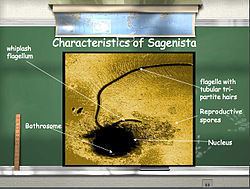Domain Eukaryota | Superphylum Heterokonta | |
 | ||
Similar Bicosoecid, Hyphochytriomycetes, Phaeothamniophyceae, Varisulca | ||
Sagenista is a group of heterokonts which at one time contained the bicosoecids and the slime nets Labyrinthulids. However at present the bicosoecids have been removed in order to make the group monophyletic, also a new group (class Eogyrea) of as yet uncultured protists were added as sister to the Labyrinthulids.
Contents
It has a special organelle called a Bothrosome. It is usually found in a marine environments rich in algae and sea grass. It is capable of movement by use of this organelle.
They are generally decomposers.
Bothrosome
They are capable of excreting an extoplasmic net of filaments for cells to glide upon. These tiny filaments provide a network for cells to travel upon to soak up nutrients from the surrounding environment.
Uses of Sagenista and Labyrinthulomycota
They are cultivated for their active production of Omega-3 fatty acids. These acids are used as an approved additive for animal feed.
Genera
Other information
Until recently Sagenista was labeled as a fungus. It produces asexually and sexually through the use of spores.
There is a debate about whether some species of Sagenista contains a photosynthetic pigment labeled chlorophyll C.
